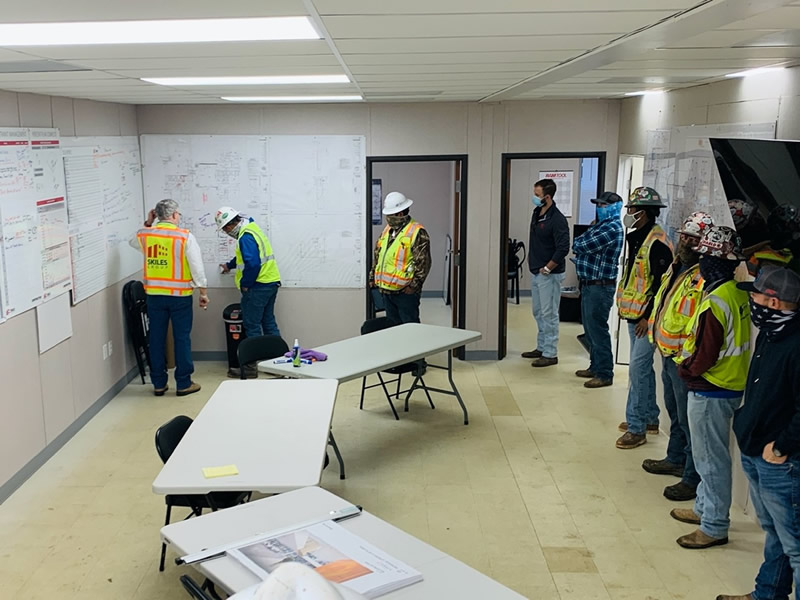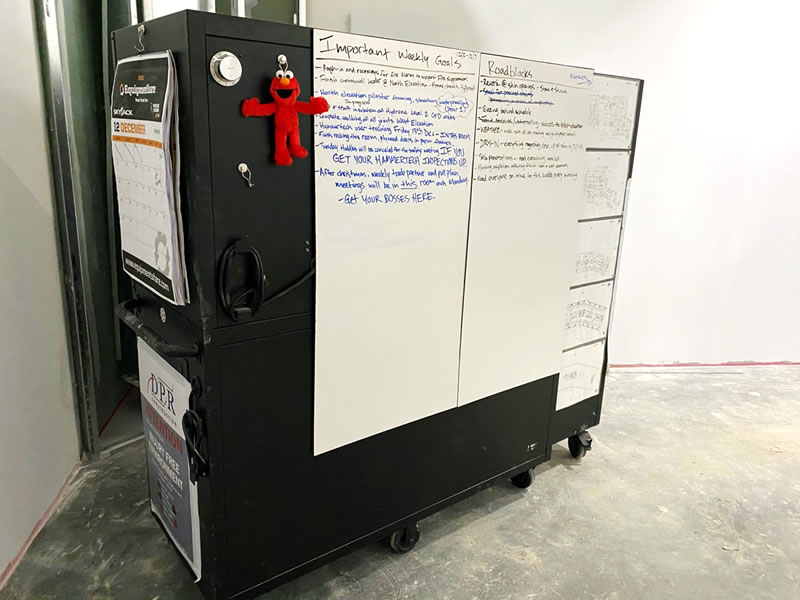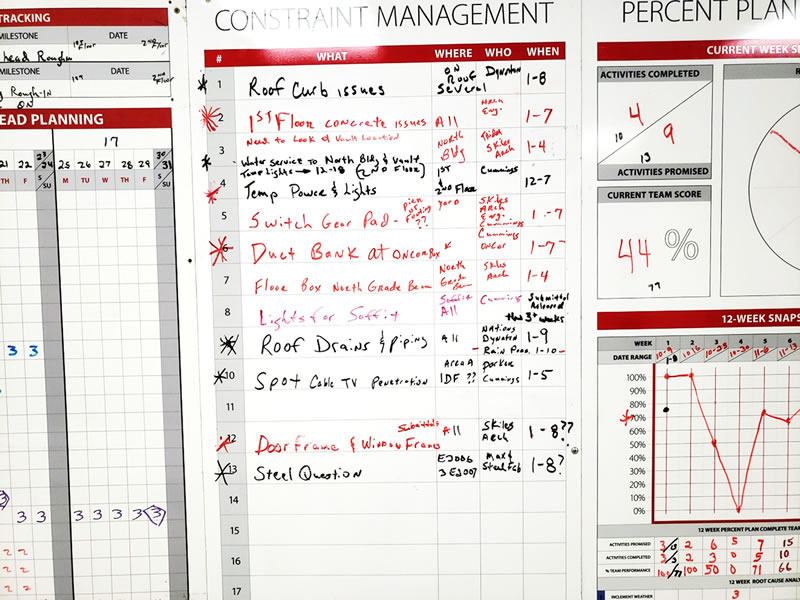Your daily team huddle should be periodically observed by a neutral party to identify what is working and what is not by using this 10 item checklist.
Daily Team Huddle Checklist
It’s a good practice to have your team’s daily huddles periodically observed to identify what is working well and what isn’t, so they can continue to improve and add more value to their projects. These observations can be done by an operations leader, another project superintendent, or someone separate from the project who can give a fresh set of eyes and perspective. But what should you look for to determine where the team’s strengths and weaknesses are? Read the list below and grade your project team’s huddle on the following questions.
1. How is the attendance?
On our construction projects, we implement a visual version of The Last Planner System® to use as our daily huddle boards. These boards include Look-Ahead Planning, Constraint Management, Percent Plan Complete, and more. As the trades begin to enter the trailer, I look to our Three-Week Look-Ahead board to be sure that the trade partners who have critical work shown on the board are present in the room, because if even one key trade foreman/last planner is missing, the huddle’s value can greatly diminished. If attendance is poor, dig for the root cause.
2. Is everyone on a first-name basis?
When the daily team huddle starts, I look to see if the project team foremen make eye contact with the others while they are talking, and I listen to find out if they know and use people’s names. You don’t want anyone on your team asking a foreman to go over their workflow and calling them by their firm’s name or using generic nicknames like “sparky” and “tin bender”. To get the most value in the huddle, the culture of trust and collaboration must be built, and that starts with learning and using someone’s name. If the foremen are smiling and joking, that is a good sign.
3. Is the project team prepared?
The huddle won’t be efficient or effective if no one is prepared. Ask yourself: are the superintendent and other project team members on time and ready for the huddle to begin? Has a six-week schedule been updated and posted where its visible to the trade foremen? Are there visual boards displayed (i.e., floor plans under laminate) and is the phasing current? During the meeting, is the project team asking relevant questions and taking notes or tracking constraints visually as the trades are describing issues or concerns?
4. Are the trade partners engaged?
Everyone should participate in the conversation. Pay attention to ensure that all the trade partner foremen spoke at the meeting, and ask yourself if they were focused, asking questions, and clearly describing constraints. If you see a trade foreman staring at their phone, not making eye contact when they speak, or answering questions in clipped sentences with few words, there’s a lot of room for improvement. Try to spend time before or after the huddle with that foreman to help them understand that this meeting is about them and the more they can offer others, the more they will get out of it.
5. Is the superintendent presenting or facilitating?
Presenting is 80% telling, 20% listening; facilitating is 20% telling, 80% listening. The superintendent’s role in an effective huddle is to allow the trade partners to discuss what they are working on, where they are working, what constraints are in their way, and if they are on track with the commitments that are documented in the Weekly Work Plan. Strong facilitators ask the right questions to draw out what is critical and push the team to make reliable commitments.
6. Is the team staying on track or getting distracted by unnecessary information?
Without intent and discipline, it is easy for the discussion to drift and wander. If this happens while you’re observing, look for the members of the huddle to exhibit the behaviors and tools needed to get things back on track. ELMO is an acronym that stands for Enough, Let’s Move On, and on our projects it’s common to see an Elmo doll chunked at someone who isn’t sticking to the topic at the huddle. It’s a fun way to break the tension of cutting someone off and letting them know what they have to say is important, but it doesn’t involve the entire team. Once ELMO has been called, the topic being discussed needs to be placed in “the parking lot,” which is a whiteboard that keeps the off-topic issues listed in one place so they can be addressed after the meeting. If you are observing huddle meetings longer then 20 minutes, most likely the team is not staying on track.
7. Are the visual communication tools being utilized?
Your team’s visual communication tools aren’t useful if they’re not being used. For example, we put floor plans and elevations under laminate on our projects. Each trade foreman is designated a different dry erase marker color, and they use these at the daily huddle to mark up the floor plans and visually communicate all planned activities with all construction trades on the jobsite. When a trade is describing their work, the superintendent should be saying “show me” to prompt the trade to use the visual board. Make note of the visual communication tools that are present and make sure they’re being incorporated into the team’s discussion and work planning.
8. Are constraints being captured?
Constraints should be identified during the normal course of conversation at your daily huddles. How diligent and thoughtful you are about capturing and organizing these constraints will determine how successful you are in alleviating these constraints for your trade partners. Using a visual board will help with this. Look for your project team to write down the constraints as the trades bring them up, but don’t stop there. They should also capture the location, the responsible person for removing the constraint and a time frame for its removal. The more the team is discipled on this the better outcome you will have.
9. How are activity failures being addressed?
At Friday’s huddle, each last planner should be able to answer if the work they committed to on the Weekly Work Plan is complete. If the if the answer is no, it is important the team know why the commitment was not met, because you can’t effectively correct the variation if you don’t identify the root cause. Some predetermined root causes for missed commitments include weather, manpower, machinery, design, make-ready, materials, and poor scheduling. Every missed commitment should be followed up with an email, phone call, or both. For example, if work is delayed because a submittal wasn’t returned and now material is missing, then the root cause is design. A follow up would be a call to the design team along with an email to try to resolve the issue. If root causes for failures are not being addressed, project flow will continue to be an issue and the last planners will lose trust.
10. Did the huddle finish on time?
The project foremen are busy, they have a lot going on in the field, and their time is valuable. If they come in for what’s supposed to be a 15–20-minute meeting and it lasts an hour, they most likely won’t attend the next one. There is a lot of value in starting and finishing your meeting on time. It fosters productivity, it makes a good first impression, and it shows that you value your attendees’ time. By continuously enforcing the promised time restraints, you are demonstrating follow-through in keeping your word.
Observing the daily huddles on your projects and looking for these 10 things your project teams will help you to help them to continuously improve, further their journey with Lean, and add more value to their projects. If you have other steps to share, please add to the conversation in the comments below.












